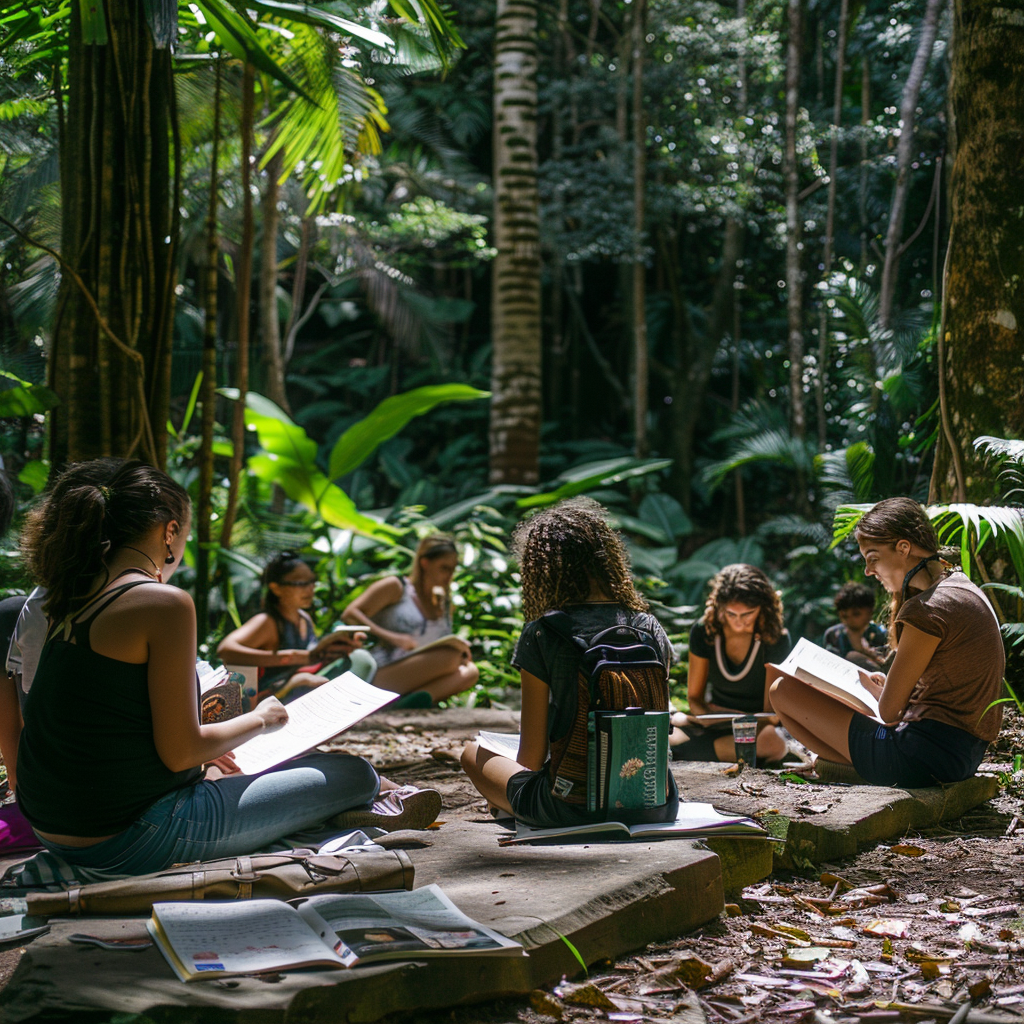Spanish Lessons in Natural Surroundings: Discover the Top 3 Empowering Spanish Schools in Lake Atitlán

Unlock the Essence of Language: Outdoor Spanish Learning Experiences
Nature’s embrace offers a sublime setting for language acquisition, and when it comes to learning Spanish, the great outdoors can be an exceptional classroom. The natural world is not just aesthetically pleasing; it is teeming with opportunities to engage all the senses in the learning process. Through outdoor experiences, learners can apply their Spanish skills in real-time interactions with their environment. Whether it’s navigating new terrain, identifying flora and fauna, or simply soaking up the sun, each activity can be transformed into a language lesson. The synergy between natural beauty and linguistic exploration makes for a compelling educational journey.
Fostering Language Skills Amidst Nature at Spanish Schools in Lake Atitlan
Learning a language is not just about mastering vocabulary and grammar. It’s an immersive adventure that can be significantly enriched by the environment in which it takes place. Learning Spanish outside the confines of the traditional classroom brings forth an unparalleled experience. The tranquility and beauty of nature can create a profound impact on the learning process. This scenic backdrop provides a calm yet stimulating atmosphere conducive to practicing pronunciation and conversing with ease. Engaging with the Spanish language amidst the chirping of birds and rustling of leaves can cement new vocabulary and grammatical structures, making learning an effortless part of the daily routine.
How Nature Enhances the Language Acquisition Process
Incorporating nature into language learning extends beyond aesthetics, serving as a mental stimulant that can enhance memory and focus. The sounds of a flowing river, the visual stimuli from a colorful landscape, and the tactile experience of the earth beneath one’s feet can all be intricately linked to the Spanish language learning process. This multisensory engagement deepens the connection between the learner and the material, embedding words and phrases into a learner’s consciousness with greater tenacity. Additionally, being in nature removes the formal constraints of traditional educational settings, allowing for a more relaxed and receptive state of mind which is crucial for language development.
Discover the Benefits of Immersive Spanish Schools in Lake Atitlan in the Great Outdoors
Embarking on immersive Spanish lessons in the vastness of the great outdoors represents a boundless opportunity to absorb language in its more organic form. The setting itself transforms into a dynamic classroom, where each element of the environment becomes a potential lesson in vocabulary and grammar. By contextualizing language usage in real-world scenarios, learners can forge a deeper understanding of Spanish semantics and syntax. Outdoor immersion is not purely about language mechanics; it marries linguistic skills with real-life experience, enabling learners to evolve from simple language users to confident communicators.
Combining Linguistic Learning with Sensory Experiences
Immersive outdoor Spanish lessons ingeniously blend the cognitive with the sensory, producing a rich learning experience. When learners step outside, every sense is engaged – an opportunity that educators seize to introduce comprehensive linguistic elements. Describing the verdant landscape or the weather patterns in Spanish embeds language structures in a practical context. This active participation with the environment allows learners to use Spanish in a manner directly relevant to their experiences, thereby solidifying their newfound knowledge through immediate application.
Semilla spanish school has adapted the sensory experience mastery level. They have transformed terrasses into classrooms with breathtaking views. What an innovative way to create Spanisch Schools in Lake Atitlan.
Why Natural Environments Accelerate Language Retention
The calm and isolation from urban distractions found in natural environments play a pivotal role in enhancing language retention. As learners engage with their surroundings, the peacefulness of the natural world helps to quiet the mind and open it up for better absorption of Spanish vocabulary and grammar. The integration of learning activities with walking, hiking, or other forms of physical engagement not only keeps the body active, but it also facilitates kinesthetic learning, which is crucial for the retention of the language. The authentic context provided by nature makes language acquisition inherently meaningful and memorable.
Cultural Enrichment Through Al Fresco Spanish Schools in Lake Atitlan
Outdoor Spanish Schools in Lake Atitlan education provides a multi-faceted approach to learning that integrates both language and culture. This method offers learners an exposure to the authentic, living essence of Spanish culture in a natural setting. Whether sampling local cuisines, engaging with community members, or simply observing cultural practices in their natural context, learners gain invaluable insights into the culture behind the language. This not only enriches their linguistic proficiency but also promotes a deeper understanding and appreciation of Spanish-speaking communities and their traditions.
Integrating Regional Culture into Outdoor Language Sessions
The infusion of regional culture into outdoor Spanish Schools in Lake Atitlan elevates them from mere language lessons to a holistic cultural experience. Whether it’s learning while meandering through a local Spanish village or while participating in a traditional dance in the countryside, these experiences immeasurably enhance linguistic proficiency. The exposure to local customs, stories, and folklore, alongside nature-based learning, provides a dynamic context for understanding the cultural nuances of the Spanish language, offering a comprehensive educational experience that goes beyond textbooks.
Guayama spanish academy offers classes with views over the lake taught by the best local spanish teachers at lake atitlan. It is definitly one of the top 3 best Spanish Schools in Lake Atitlan.
The Impact of Cultural Context on Outdoor Language Learning
The impact of cultural context on outdoor language learning is substantial, as culture shapes the way we use language in everyday life. By engaging with the Spanish language in its native context, students gain a broader perspective on its use and significance. Participating in cultural events and activities within a natural setting fosters a more nuanced comprehension of vocabulary and idioms and encourages learners to embrace the cultural aspects of language use. This immersive approach bridges the gap between textbook learning and the reality of conversing in Spanish, making the learning process both effective and enjoyable.
Expert Tips for Maximizing Your Outdoor Spanish Schools in Lake Atitlan Learning Journey
To fully maximize the advantages of learning Spanish in a natural setting, it’s essential for learners to be prepared with strategies and resources. From selecting the right educational materials to understanding the local ecosystem, every detail matters. Learners are encouraged to immerse themselves in the natural environment while remaining mindful of the learning processâbridging the gap between passive exposure and active engagement. Tips from seasoned outdoor educators often include leveraging nature’s unique features to inspire curiosity and applying language skills to express and describe natural phenomena.
Essential Outdoor Language Learning Tools and Resources
To make the most out of outdoor learning adventures, it is crucial to equip oneself with the right tools and resources. Durable, weather-resistant notebooks and pens are a must for taking notes on new words and phrases discovered in the wild. Portable language guides or mobile apps can provide quick access to vocabulary and grammar while on the go. Moreover, audio resources that can be listened to during nature walks immerse learners in Spanish pronunciation and cadence, enhancing their auditory learning.
Creating a Conducive Outdoor Learning Atmosphere
Crafting an ideal outdoor learning atmosphere requires consideration of both comfort and concentration. By choosing quiet, picturesque locations and bringing along the appropriate gear for weather conditions, learners can ensure a distraction-free study environment. Suggested accessories like weather-appropriate clothing or insect repellant can make a significant difference in maintaining comfort during sessions. Additionally, regular breaks to appreciate the environment can refresh the mind and enhance the overall effectiveness of the outdoor learning experience.
Case Studies: Success Stories of Spanish Schools in Lake Atitlan Learning in Nature
The transformational power of nature on language learning is substantiated by numerous success stories from individuals around the world. Case studies highlight how learners can rapidly progress in their Spanish language skills when immersed in natural environments that stimulate both mind and spirit. These anecdotes underscore the importance of context in language learning and demonstrate how nature, as a dynamic and inspiring setting, can have a profound effect on linguistic growth and confidence.
Real-Life Testimonials from Outdoor Language Learners
Testimonies from those who have embraced outdoor language learning speak volumes about its effectiveness. Students often report a greater sense of relaxation and enjoyment during their studies, which contributes to a more positive and fruitful educational experience. In some cases, individuals credit the natural setting for their marked improvement in both confidence and conversational aptitude, proving the potent influence that environment has on language proficiency.
Measuring Progress: Long-Term Benefits of Environmental Language Learning
Assessing the progress of students who have engaged in environmental language learning reveals the enduring benefits of this educational approach. The integration of nature into language learning not only augments the immediacy of linguistic comprehension but also strengthens long-term retention and linguistic agility. Students often find that their command of the language is bolstered by the diverse experiences provided by an outdoor learning context. Moreover, the environmental component tends to instill in learners a lifelong appreciation and enthusiasm for the Spanish language.
Optimizing Your Language Skills with Nature’s Rhythms at Spanish Schools in Lake Atitlan
Leveraging the innate rhythms of nature can significantly optimize one’s language learning process. Adapting language instruction to align with the day’s natural ebb and flow allows learners to harness the power of environmental cues and make the most of their study sessions. Furthermore, by tuning in to the subtleties of their surroundings, students can cultivate an enhanced ability to notice patterns and variations in Spanish, much like the variations found in nature. This technique enables them to weave language learning into the fabric of daily life, thereby reinforcing language skills and increasing proficiency.
Adapting to Natural Elements in Language Instruction
The natural world operates on a rhythm of its own, a reality that outdoor language programs artfully incorporate into their instruction. Adjusting lessons according to the time of day, weather conditions, or seasonal changes provides a fresh and dynamic approach to learning Spanish. This fluid adaptability to the natural world not only invigorates the curriculum but also mirrors the fluid nature of language itself—ever-changing and adaptable to various contexts.
The Role of Serenity and Mindfulness in Outdoor Language Education
Serenity and mindfulness, which are naturally cultivated in outdoor settings, play a pivotal role in enhancing the effectiveness of language education. The tranquility of natural landscapes fosters a meditative approach to learning, where students can practice Spanish with a heightened sense of focus and without the common distractions of a typical classroom setting. By immersing themselves in the present moment, learners become more attuned to the nuances of the language and can approach their studies with a greater sense of awareness and intention.
Jardin de America Spanish school teachers their students under lushious green gardens surrounded by the sounds of nature. They also offer an immersive experience both with nature and with the local culture.
FAQ: Questions and Answers of Spanish Schools in Lake Atitlan
Where is the best place to learn Spanish?
The best place to learn Spanish can depend on the learner’s preferences and resources. Language immersion is widely considered one of the most effective ways to learn, so studying in a Spanish-speaking country like Spain or a Latin American country can be very beneficial. However, not everyone has the means to travel or live abroad, so alternative options include local language schools, community college courses, online platforms such as Duolingo, Babbel, or iTalki, and language exchange meetups. Universities often offer comprehensive language programs, while apps and online courses can provide flexible learning schedules for self-study.
Is there an easy and natural way to learn Spanish?
An ‘easy and natural way’ to learn Spanish, or any language, is to create an immersive environment. This could mean listening to Spanish music, watching films and TV shows in Spanish, or speaking with native speakers. Applications like Rosetta Stone or Pimsleur approach learning in a more natural, intuitive manner, emphasizing speaking and listening over grammar. Practice consistently, and aim to think in Spanish rather than translating in your head. Additionally, structured lessons and conversational practice can be supplemented with language-learning podcasts or mobile apps, which can make learning more accessible and enjoyable.
How do you incorporate Spanish into everyday life?
Incorporating Spanish into everyday life can be done by integrating the language into routine activities. Label items around the home in Spanish, change device settings to Spanish, or follow Spanish-speaking social media accounts. Engage in hobbies that involve the language, like cooking Hispanic cuisines with recipes in Spanish. Setting aside specific times for practice each day helps reinforce learning. Participate in language exchange events or find a Spanish-speaking pen pal to practice writing. Local Hispanic cultural events and restaurants also offer opportunities to engage with the language and culture.
Are there Spanish immersion programs in the US?
Yes, there are numerous Spanish immersion programs across the United States. These are often offered by universities, language institutes, and private companies. Programs may range from weekend retreats to semester-long courses and are available for all age groups. Immersion programs often combine language instruction with cultural activities, providing a holistic learning experience. Some programs are intended for professionals who need to learn Spanish for work, while others might cater to travelers or students seeking a deeper cultural understanding. Researching and visiting these programs can help determine the best fit based on goals and available time frame.
What are the benefits of becoming bilingual in Spanish?
Being bilingual in Spanish has numerous advantages. In the professional realm, it can open up job opportunities, facilitate international business communication, and give a competitive edge in the workforce. It can also broaden cultural understanding and appreciation, improve cognitive abilities like multitasking and problem-solving, and promote better memory and decision-making skills. Socially, it allows for easier travel experiences in Spanish-speaking countries and the ability to connect with the Spanish-speaking community both locally and globally.
Can learning Spanish help in career advancement?
Absolutely, learning Spanish can significantly aid in career advancement, particularly in industries such as healthcare, education, international business, law enforcement, and social services, where communication with Spanish-speaking clients or partners is often required. Bilingual individuals may access a broader range of job prospects, negotiate higher salaries, and position themselves as valuable assets to their employers, especially as the Hispanic population in the U.S. continues to grow and globalization increases the need for multilingual professionals.
How much time does it typically take to become fluent in Spanish?
The time it takes to become fluent in Spanish can vary greatly among individuals and depends on factors like the learner’s native language, language-learning background, the intensity of study, exposure, and individual aptitude. For English speakers, the Foreign Service Institute categorizes Spanish as a Category I language, estimating approximately 600-750 classroom hours for proficiency. However, immersion experiences and daily practice can significantly accelerate this process.
What role does cultural immersion play in learning Spanish?
Cultural immersion plays a crucial role in learning Spanish as it allows students to experience the language within its native context. Immersion aids in understanding linguistic nuances, slang, and idiomatic expressions that are often not covered in formal education. It promotes frequent practice in realistic scenarios, enhances listening comprehension, and increases the need to communicate effectively in Spanish. Cultural exposure broadens the learner’s understanding of social norms, traditions, and the diverse Spanish-speaking world’s perspectives, enriching the language-learning journey.

Summary of Spanish Schools in Lake Atitlan in natural surroundings
In conclusion, our exploration of learning Spanish outdoors has showcased nature’s charm and its profound impact on language acquisition. We’ve witnessed how natural environments enhance language skills and retention, recognizing their cultural richness. Expert advice emphasized the need for suitable tools and strategies, with success stories affirming lasting benefits. By embracing nature’s rhythm, we’ve learned how serenity aids language learning. This holistic approach energizes linguistic abilities and enriches the soul. Whether seasoned or beginner, the invitation stands: step outside, breathe, and let nature inspire your Spanish journey.
Are you looking for somewhere to stay? At Eagles Nest we offer all inclusive rooms. Along side daily activites, yoga classes, mouthwatering food and breathtaking views. Also, we are located at walking distance from some fantastic Spanish school in downtown San Marcos. Book here.



